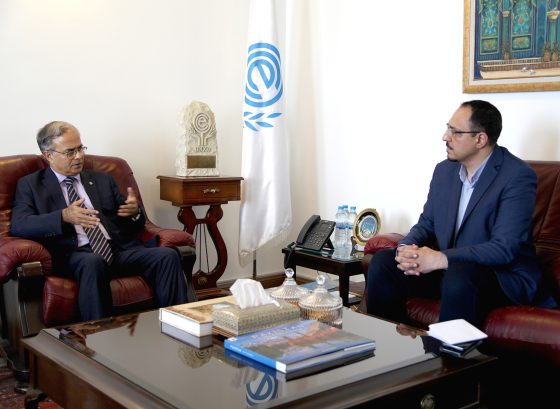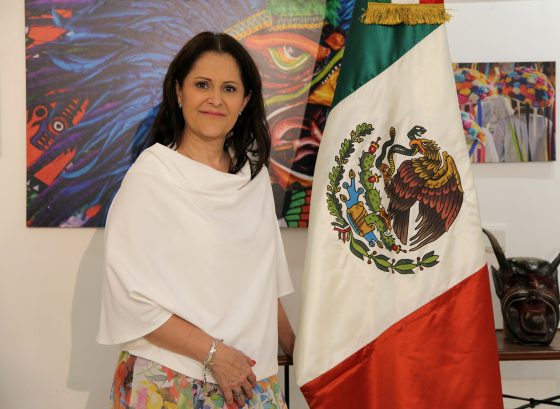“Buddhism is Intertwined with, and Woven into the Very Fabric of the Bhutanese Society.” Says Mrs. Bindhya Priesner
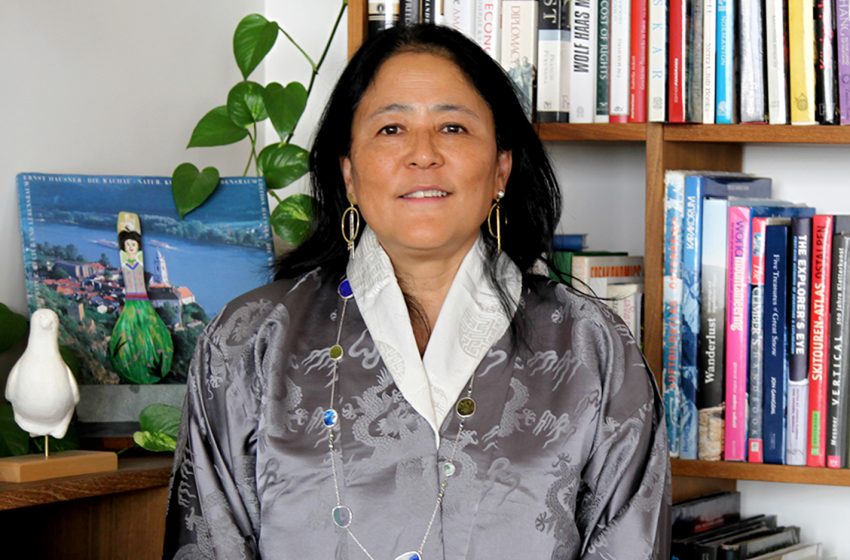
Mrs. Bindhya Priesner who was born in Paro, Bhutan, had a spirited and exciting childhood. Attending a boarding school and later higher education in India and England played a significant role in shaping her independent personality. In addition, the peaceful coexistence of the followers of different religions in Bhutan has formed her attitude towards religious pluralism. She believes that women in Bhutan have always enjoyed a remarkable social position. They are independent and empowered individuals and are active at various managerial and political levels; however, there are still many opportunities for them to play a wider role in political decision-making processes.
AVA Diplomatic’s Exclusive Interview with Mrs. Bindhya Priesner,
Spouse of the United Nations Resident Coordinator and President of the Diplomatic Spouse Group (DSG)
Where were you born and how did you spend your childhood and young adult years?
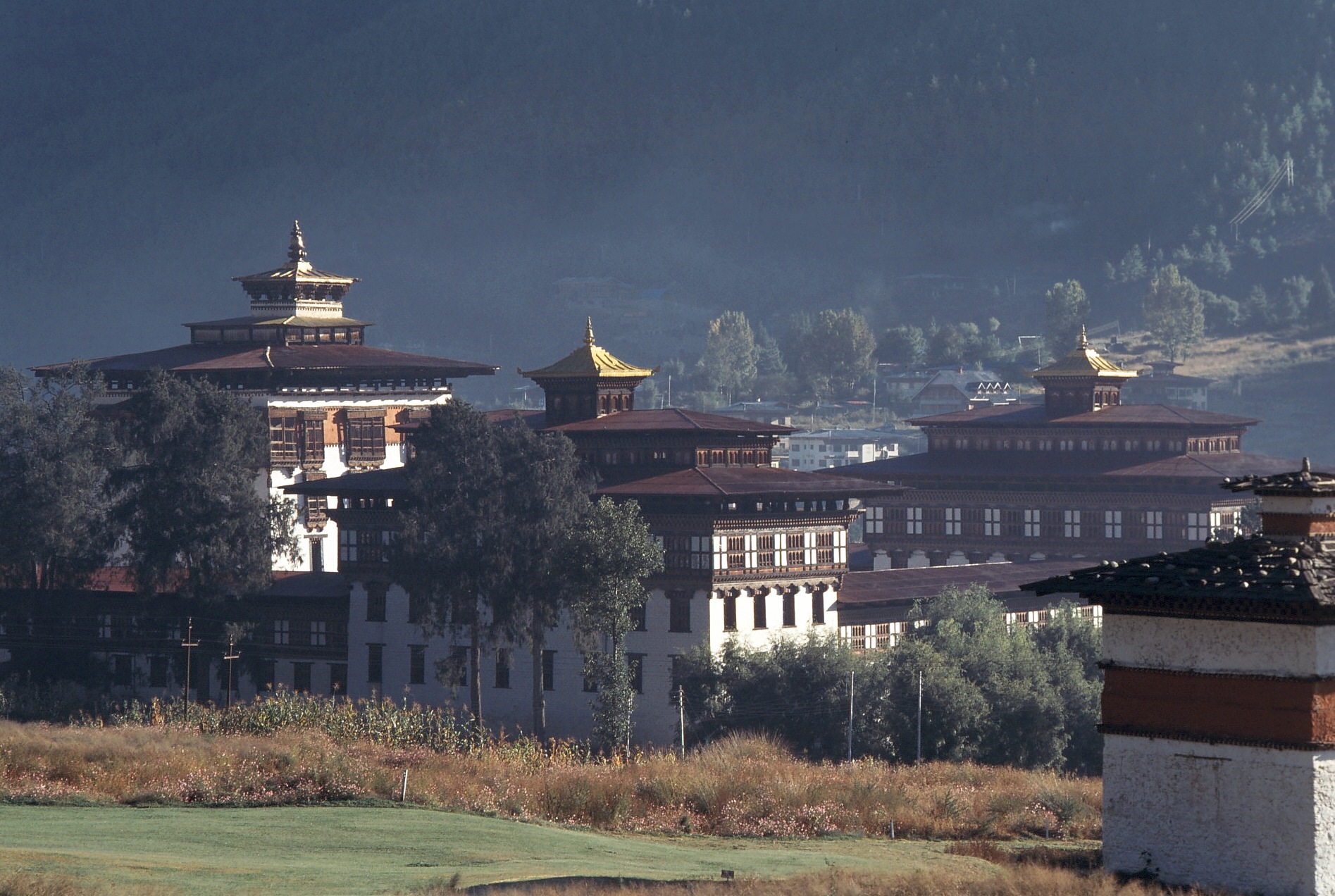 I was born in Paro, a small town in the Himalayan kingdom of Bhutan (at home), as those days there were no hospitals built yet in my area. I went to a local school in my village at the age of 3 along with my sister, who was 7 at that time. I was her responsibility hence I went where she went.
I was born in Paro, a small town in the Himalayan kingdom of Bhutan (at home), as those days there were no hospitals built yet in my area. I went to a local school in my village at the age of 3 along with my sister, who was 7 at that time. I was her responsibility hence I went where she went.
I didn’t do much studying really – more inclined towards playing and was a major disturbing influence on my older sister because of the scrapes I used to get into, which inevitably she had to get me out of!
I can describe my childhood as idyllic at its best. My parents were of the opinion that girls can do whatever boys can and therefore raised no bars.
For instance, when boys in my neighborhood were scared of playing with the bear cub – which was found by the Crown Prince in the Forest with a dead mother bear and was placed in our compound with a caretaker – I often went and played with it. Pure bravado really until my mother utterly forbade me because the bear had turned feral as it got older.
When I reached the age of 10, I was sent to a boarding school two days away from where my parents lived because I got high marks during the All-Bhutan common examination. I grew up fast once I learned to navigate moving between two towns, two days long bus journeys away from each other, and part of it traveling through India! This experience and early independence helped me later for my university studies in India and with my studies at the London School of Hygiene and Tropical Medicine.
Who influenced you the most when you were a teenager?
My parents for sure!
My mother was like a queen bee as she managed everything in the house and was also very entrepreneurial. Her famous words to us were: ‘You have got brains in your head and shoes on your feet, and you can turn your feet in any direction you want it to go.’
My Dad who was a loving and generous man once told me after I got into trouble in school instead of scolding me – I must have been about 11/12 years of age – that he wasn’t rich and couldn’t give me land and property. The only thing he could give me was the possibilities and doors that could be opened by giving me the chance of an education. He couldn’t make me study or avail of those opportunities unless I wanted it myself. I never forgot that lesson!
What place do folk music and dances hold in Bhutanese culture?
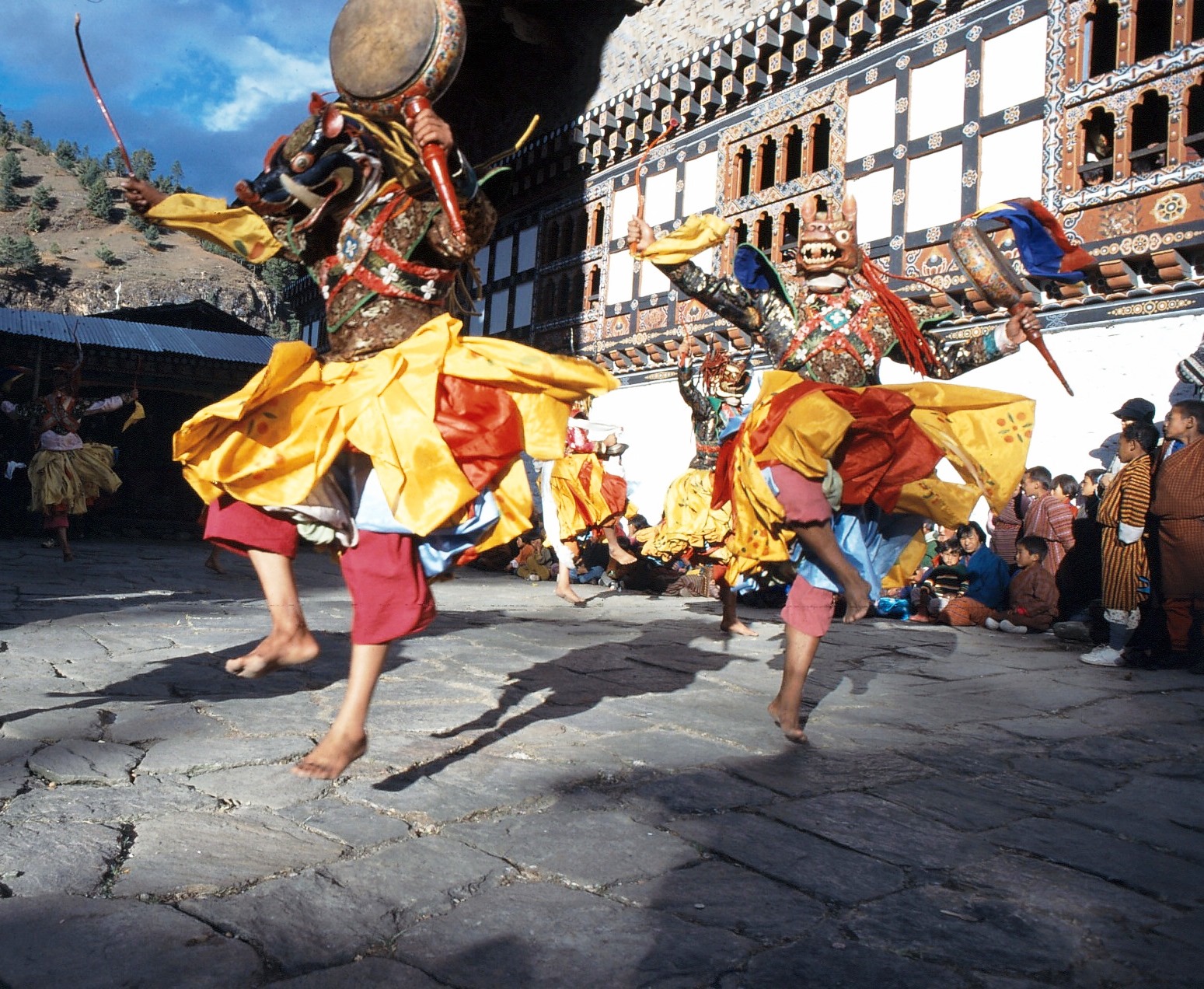 Like in many cultures music and dances play a central role in our culture. Much of our music and many dances are based on religion, as they are performed by the Buddhist monks that live in the Dzongs – administrative fortresses.
Like in many cultures music and dances play a central role in our culture. Much of our music and many dances are based on religion, as they are performed by the Buddhist monks that live in the Dzongs – administrative fortresses.
These Dzongs are huge castle like structures usually built on a high point (top of a mountain or a ridge) and traditionally also served as safe havens in times of danger or attacks. Beside the secular administration, they also accommodate the local monk body, and a lot of our dances are performed by them during festivals with trance like movements, wearing masks, colorful outfits with lots of jumping and quick movements. These festivals that last several days, bring huge crowds together to make the festivities a social highlight with plenty of food, butter tea and home brewed drinks to share. Music for dances are made with long horns with animal bones in it, short horns, flutes, gigantic cymbals, and drums.
In addition, any festival, marriages, births are celebrated with men and women singing and dancing to folk music, which can be very specific to different parts of the country.
What are the most important cultural values in Bhutanese society?
It is largely a Buddhist society, and Buddhism teaches us to be kind to all living beings. Every creature big or small has a place and a role to play therefore being generous towards those who are weaker than you is considered the norm.
Practice of religion is considered your private affair, and it is up to you how much you donate towards the prayers in the monasteries, for the wellbeing of the people and the world at large.
The majority of the population is of Buddhist faith, followed by about 25% Hindus, and a small Christian minority.
Festivals such as Losar (our New Year which follows the lunar calendar), and Buddhist festivals like birth and death of Gautama Buddha and other auspicious important dates that stem from the lives of learned monks and teachers of Buddhist faith are celebrated by all. And, in addition, the population also celebrates Hindu festivals like Diwali – festival of lights, Dashera – victory of the good – similar to India and Nepal.
Even the royal family members starting from our King, participates in these festivities, showing by their actions, that all religions have their space, and we can all enjoy our differences by sharing and collaborating with each other.
How is the role of family defined in Bhutanese culture?
 The family forms the core of Bhutanese society as traditionally we tended to live in a big joint family system. If marriages/relationships don’t work out, there is no stigma attached to the woman /man or child as your large family absorbs you and your child /children can grow up amongst many cousins, uncles, aunts and grandparents!
The family forms the core of Bhutanese society as traditionally we tended to live in a big joint family system. If marriages/relationships don’t work out, there is no stigma attached to the woman /man or child as your large family absorbs you and your child /children can grow up amongst many cousins, uncles, aunts and grandparents!
With modern society, in cities parents live with their children but nevertheless being part of a large family is still highly valued.
Parts of Bhutan have a matrilineal society where the eldest or the youngest daughter inherits the entire parents’ property/fortune, as well as takes over the care of the parents in their old age.
We have a saying in our language: ‘that daughters remain your daughters no matter who they marry, but sons can easily become the person of their wives”. Therefore, girls tend to bring their husbands to their home, and boys leave their parents’ home to move into the girl’s home after marriage. However, this is also changing with the modern legal system in place, which now requires parents to divide their property equally between all children regardless of their gender.
Are there any special handicrafts in Bhutan?
 We have 13 specific handicrafts in the country, which are protected and promoted by the state. There are even special schools /centers set up that teaches those crafts and promotes its products in-country and abroad.
We have 13 specific handicrafts in the country, which are protected and promoted by the state. There are even special schools /centers set up that teaches those crafts and promotes its products in-country and abroad.
These include weaving on different kinds of loom, brass and copper work, stone sculpture, woodwork including wooden sculpture, Thangka (prayer tapestry) embroidery, religious paintings, shoe making with cloth and felt, silver and traditional jewellery usually worn with our traditional outfits. These crafts take a lot of time and skill to make, therefore they are expensive. Usually most of these skills for crafts are passed from family to family for generations but nowadays one can also learn these skills at the handicraft schools and centers.
Our National dress – ‘Kira’ (floor length robe of 4x5m rectangle piece that is wrapped around the body) for women and ‘Gho’ for men (short knee length skirt similar to a Scottish kilt, like a robe) uses hand woven materials to complete the entire outfit, which consist of several separate pieces. The daily usage in our regular wear enables to keep the weaving craft and industry alive and thriving.
What is the dominant religion in Bhutan and to what extent does it influence people’s lives?
Buddhism is intertwined with, and woven into the very fabric of the Bhutanese society!
Buddhist concept holds that sentient beings do not have an independent existence but rather is part of a web of relationship with all dimensions of nature. Buddhists perceive reality as circular with human life regarded as just one state in an eternal cycle of reincarnations.
This alters our relationship to the environment since sustainable development is in everybody’s self-interest.
Buddhist moral philosophy provides definition of happiness, and our wellbeing and happiness is drawn from a balance between spiritual and material aspects of life.
How have new technologies affected the culture and lifestyle of the Bhutanese people?
Bhutan entered modernity late, especially regarding TV and internet, which were only formally introduced in the country in 1999. Since its introduction it has changed the lifestyle of the population a lot while bringing in a lot of benefits as well.
People in far off villages have access to mobile phone, WiFi services, enabling them quick access to markets, hospitals and new information. At the same the old ways of families gathering in evenings or at mealtimes, sitting around the fireplace etc. are disappearing.
Young people are also leaving the country for opportunities in western countries for education and jobs. Bhutan as a small country cannot afford this human brain drain although since families still play a crucial role in the well-being of an average Bhutanese person, many tend to return and invest in the country.
How does the educational system of Bhutan help preserve and promote national culture?
The educational system in the country was initially established based on the Indian/British model, with teachers recruited from India. Over time, educators from Canada, the UK, and Australia also contributed to the system. Meanwhile, Bhutanese teachers have received training at teacher training institutes in India, at local institutions within Bhutan, and many have returned with master’s degrees in education from abroad.
The language of teaching is in English, which for many Bhutanese has provided a gateway to the outside world.
However, learning our own national language, Dzongkha and the country’s history and geography, which is taught in the local language, is equally important. Other languages widely spoken throughout the country is called Lhotsamkha (or the language of the south), which is Nepali, and Sharchopkha (language of the east).
Has Bhutan encountered any challenges in terms of globalization and its impacts on local culture?
Bhutan is small country in the Himalayan mountains and was never colonized. It started to open itself to the outside world and modernity much later than our neighbors. In addition, the government opted for a slow and gradual opening including the access to and use of modern technology.
Today Bhutan has a young population and natural resources are being exploited as new industries are created to meet the demands of the rapidly growing population.
It has limited arable land and villages are sparsely populated. As in other countries the impact of climate change is also changing the landscape of the county.
There are also fewer stewards of the land as people migrate to urban areas/cities/larger towns/abroad to foreign countries in search of perceived and real comforts of modernity.
On the other hand, globalization brought development, prosperity, and longer life expectancy.
So, it is a mixed story of positive and negative impacts.
What is the Bhutanese government system like and what are its features? Are there political parties active in Bhutan? How is the role of the king defined in Bhutanese politics?
Bhutan is a relatively young monarchy, with the current King being the 5th in a line of hereditary rulers dating back to the early 20th century. In 1996, his father, the 4th King, abdicated in his favor at the age of 51, and, in a historic move, dissolved the Council of Ministers he had appointed, effectively handing democracy over to the people.
Today, Bhutan operates as a constitutional monarchy with a parliamentary system. The King serves as the head of state, while the Prime Minister, elected by the people, is the head of government. The upper house, the National Council, consists of 25 members, while the lower house, the National Assembly, has 47 elected members. Several active political parties exist, with the two strongest parties typically competing in the run-off elections. So far, no political party has ever held power for more than one consecutive term.
Are there any plans in Bhutan to increase the participation of women in political decision-making?
The education system and job market in Bhutan provide equal opportunities for both girls and boys, with higher enrollment rates for girls in primary schools. However, as in many parts of the world, women often face setbacks in advancing their careers due to responsibilities such as childbirth, child-rearing, and caring for the elderly and sick, which often lead them to take breaks from climbing the professional ladder.
However, Bhutanese women are fairly empowered, take independence seriously, and are often entrepreneurial therefore it is not uncommon to have female headed households, or large-scale businesses with women at the top management level /or as owners, and they are ever present in high level government positions, as well as in the parliament, and active at the grass roots political level.
Regarding political decision making there is a need for further improvements, as women are still underrepresented. Government has specific gender-based programs to give them more opportunities.
How has climate change affected the lives of the people in Bhutan?
Bhutan elevation begins at 300m above sea level, where the Indian plains end, and the mountains begin, with some towns of the Inner Himalayan valleys that are situated at 2000-3000m above the sea level. Our highest mountain Ghankar Phuensum is above 7550m! These towering mountains are permanently snow-capped, but, like many other parts of the world, they are increasingly affected by global climate change, causing glaciers to recede.
The glaciers play a crucial role in feeding the rivers below, providing fresh water for agriculture and other essential needs. However, the melting glaciers also pose a significant threat, as there is the risk of glacier lake outbursts, leading to catastrophic flooding in the valleys, along with substantial human and economic losses.
When I was young, many of our valleys would experience snowfall in winter, and we even had special holidays on the first day of snow, with typical snow games we loved to play. These have now become distant memories, as many young people rarely experience snowfall at all.
In Bhutan, are the expenses related to the wedding party (such as renting a hall, catering, etc.) and providing a dowry borne by the family of the bride or the family of the groom?
Weddings used to be a family matter with mostly parents arranging the matrimony but with both the prospective groom and the bride fully in agreement.
There is no dowry system in the country!
The celebrations where extended family, friends, neighbors are invited vary depending on the income and the social standing of the people concerned. Both sides of the family tend to contribute to the wedding, or the young couple themselves in many cases, nowadays.
For those unwilling /unable to spend, sustained living together counts as marriage. While one is encouraged to legally obtain a document from the court especially in connection with separations, where property division comes into play, many couples still take years to obtain the physical marriage certificate!
How did you meet your husband? What qualities in him attracted you? How was your wedding celebrated?
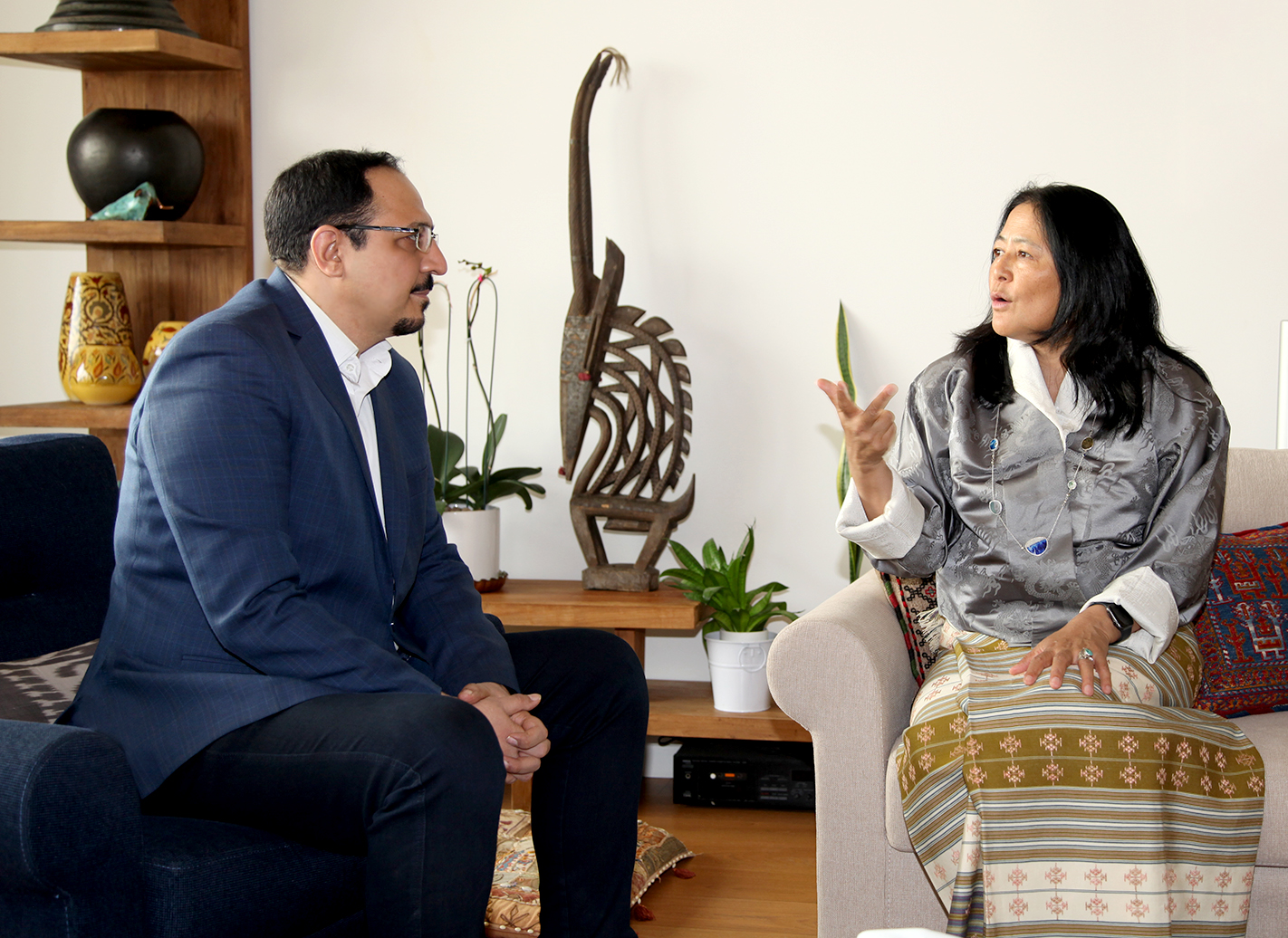 I met my husband in Bhutan when he came to the country as a graduate student of Johns Hopkins University for his final thesis research work on the Bhutanese concept of ‘Gross National Happiness’.
I met my husband in Bhutan when he came to the country as a graduate student of Johns Hopkins University for his final thesis research work on the Bhutanese concept of ‘Gross National Happiness’.
My husband was the first person who researched, analyzed and wrote about this concept, and how it fitted into Bhutan’s development over the years. I was working at that time for the Danish Development Assistance and later joined UNICEF.
I was drawn by my husband’s keen idealism, empathy and unshakeable belief in the good of humanity, and his sense of adventure through his stories of the amazing trips he had undertaken. I wanted to be part of that life!
We had a court wedding in Bhutan, followed by a wedding party in Austria with friends and family joining us from all over the world to celebrate with us.
Though we come from different corners of the world, our intercultural journey together has been incredibly enriching. Our bond has always been a source of strength, and with the joy of raising two children, it has only deepened over time!
What are the characteristics of traditional bride and groom wedding outfits in Bhutan?
We wear the National dress of Bhutan, just more colorful and with more patterns, or woven with gold and silver threads. It takes months to weave enough material for one person’s dress and depending on the intricacies or details in the garment it can be very expensive.
What challenges and opportunities does life bring as a diplomat’s spouse?
I wish to focus on the opportunities that our lifestyle provides. This is our 7th duty station and the first one without our children, who now attend universities.
In our diplomatic lives, constantly moving between countries, we are fortunate to balance the needs of our families while growing as global citizens.
As diplomatic spouses, we are presented with the unique opportunity to explore and adapt to diverse lifestyles. While there may not be a clear career path, this lifestyle offers us countless small, unexpected opportunities and breathtaking experiences along the way. It’s up to us to seize these moments and make the most of them.
One of the greatest challenges, of course, has been raising our children in such a constantly changing environment. Despite the challenges, they often tell us how much they enjoyed their upbringing. Similarly, being far from our parents as they age presents its own difficulties, especially when they need us most.
Please explain about the most popular dishes in Bhutan? How and with what ingredients are they prepared?
Our National dish is called ‘Ema Datshi’ which consists of about 30 or more chilies cooked in thick (yak or cow milk) cheese sauce. We use very few ingredients to make this dish. It is usually eaten with red rice – a variety that is indigenous to Bhutan.
The dish is extremely spicy as chilly is used in our kitchen as a vegetable and not as a spice. To cater to our immense chilly usage throughout the year, we Bhutanese have invented many ways to dry the chilies to use it during off-season.
We also consume a lot of noodles, which are typically made out of rice, wheat flour, buckwheat, millet, which is again mixed with lots of chilly flakes in the dough. Rice and noodle dishes with chilly pickle/sauce – ‘Eyshey’ – can be eaten 3 times a day!
In your opinion, what are the biggest cultural differences between Iran and Bhutan?
Rather than focusing on differences, I believe it’s important to highlight the similarities. For example, people in both countries are incredibly friendly, helpful, and hospitable. I love how, here in Tehran, complete strangers greet you both in the city and the mountains, often inviting you to share their food. It reminds me of home, where the Bhutanese are also known for their warm hospitality and generosity.
On top of that coming from the mountains where I have always enjoyed hiking, the mountains of Tehran continues to provide me this space to explore my love of being outdoors.
What was your first impression of Iran when you first entered the country? What things in Iran have surprised you?
We decided to come to Iran, and our time here has been as full of discovery as we had hoped. I have thoroughly enjoyed living in Tehran—interacting with its warm and welcoming people, exploring the diverse art galleries and museums, tasting the delicious variety of food in charming cafes and restaurants, and, of course, taking advantage of the wide range of outdoor activities available throughout the year. It still amazes me that the country experiences all four seasons at the same time, depending on which region you’re in!
Iran’s rich history, stunning monuments, and UNESCO World Heritage sites like Persepolis, the grandeur of Isfahan, and the Zoroastrian monuments in Yazd have brought the stories from history books to life for me. I am truly grateful for the rare opportunity, through my husband’s work, to live in this incredible country and experience a small part of its richness and diversity.
Which Iranian food is closer in taste to Bhutanese cuisine?
None of the Iranian food is anywhere near Bhutanese food in the way we prepare them other than the fact that our dishes are also very much meat (but dried) and rice based!
As the President /member of the Diplomatic Spouses Group in Tehran, how has this group helped you to be more productive in Iran? Please tell us about the important achievements of the membership in this group.
 I have had the honor of serving as the President of the Diplomatic Spouses Group (DSG) for the past three years. The DSG is an informal community of about 100 diplomatic spouses living in the country, where we offer friendship, support one another, and help each other navigate life in our host city. It also provides us with a platform to exchange ideas, nurture our shared interests, and deepen our understanding of the country we live in.
I have had the honor of serving as the President of the Diplomatic Spouses Group (DSG) for the past three years. The DSG is an informal community of about 100 diplomatic spouses living in the country, where we offer friendship, support one another, and help each other navigate life in our host city. It also provides us with a platform to exchange ideas, nurture our shared interests, and deepen our understanding of the country we live in.
Leading this group has been an incredibly rewarding experience, and I take great pride in guiding its direction. It’s especially energizing for me to see the joy and enthusiasm others bring when participating in the activities we organize as a group.
We are an active group that meets regularly to explore the many facets of life in Tehran. For instance, through our ‘Hiking Group,’ we venture into the stunning mountains surrounding the city, while our ‘Designers’ and ‘Meet the Artist’ groups uncover the impressive local talent. Our ‘Gourmet Group’ offers the chance to explore Persian cuisine, as well as share and celebrate the culinary traditions of our own cultures. Additionally, we have specialized groups tailored to the unique interests and needs of the diplomatic children.
My own personal motto is ‘why reinvent the wheel when someone else has done it or knows it better’. We can learn from each other, support one another and make our time in Tehran a much richer and fulfilling experience by doing things together.
What lessons have you learned from living abroad and different cultures?
Every country has a rich heritage and culture to offer, regardless of where we live. In my view, it’s important to keep an open mind and let these experiences guide you toward enriching your life. I’ve found that people are generally kind everywhere, and how we connect with the local culture largely depends on our approach as individuals.
We can always learn from one another, bringing together our strengths and curiosity. All it takes is openness to new people and new experiences. By embracing this, we’ll all become better versions of ourselves.
Which UN agencies have you collaborated with? What has been the subject of these collaborations?
While I am the spouse of the Head of the UN in Iran, when I first met my husband many years ago, I was working in the development field. I started my career with Danida, and then later moved to UNICEF, and over the years, I worked as an external short-term consultant on specific projects for various international organizations, including IOM, ESCAP, and UNAIDS. Throughout this journey, I have developed a deep belief in the UN’s values and its noble mission, as well as a profound appreciation for the people who are dedicated to advancing its goals.

